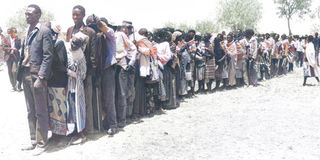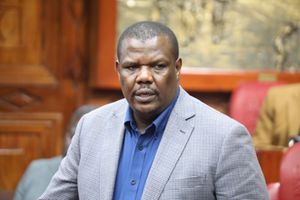History of election mischief in Kenya: From mlolongo system to vote buying

Voters use the queue-voting method during Kanu elections in the '80s. President Moi adopted the voting method, popularly known as mlolongo, in the 1988 General Election.
Once upon a time, each candidate at the General Election was assigned his own ballot box. It is the ballot papers inside your box that determined the poll outcome.
The ballot box was only identified with your campaign photo – and in some cases, if you have no agents, the photo and the ballot box could disappear. In some places, some ballot boxes disappeared forever. There was a time we could also post our marked ballot papers to the returning officer.
Welcome to the history of Kenya’s dalliance with rigging, which is as old as the independent nation state. Before we lost trust in ourselves, ballot papers used to be printed by the Government Printer – right there along Haile Selassie Avenue, where my old friend Mwenda Njoka now sits as the boss. Right now, simply because politicians cannot trust any local firm to print the ballot papers, least of all the Government Printer, we continue to throw away our dollars to foreign printers. It is the cost we continue to pay.
There is a history to that, too – and I will come back to it later. The history of our democracy sounds like a thriller, if you can dig into the rigging practices that have happened over the years. So, Mr Wafula Chebukati, the chairman of the Independent Electoral and Boundaries Commission (IEBC), should take heart when politicians raise their voices. He is, perhaps, lucky that a lot of ground has been covered.
In the 1963 General Election, for instance, one of the most outstanding rigging practices was to make sure that candidates, not in the government’s good books, did not know their election symbols – until it was too late to do any meaningful campaign. By then, the elections were conducted by the Supervisor of Elections, which was a department within the Attorney-General’s chambers. The work of picking, approving, and assigning symbols had been left to the Returning Officers who were to send them to the Supervisor of Elections in Nairobi. It happened that the Returning Officers were District Commissioners – and they could frustrate any perceived anti-government candidate.
Print posters
In 1974, when the election laws were being amended, Mr Martin Shikuku, then Butere MP, recalled what happened in 1963. “Some of us did not know what our symbols were until the last day. After you have known what your symbol is, you rush to the press (to print posters). We should all understand that the press does not belong to us. Since I had not known what my symbol was in good time, my opponent used the opportunity to tell the people I was not standing. He had been informed what his symbol was a week earlier than me.”
The next phase of mischief was in the 1969 General Election when each candidate had his own ballot box. As the late JM Kariuki, the Nyandarua North MP, complained in 1974, ahead of the General Election, the government did not tell the candidates how this would work. “They never let us know how the ballot box would be; they never indicated to the public that there would be individual boxes. So what happened? Anybody could carry as many votes as he could in his pocket and put them in the ballot box.”
So how did people access the extra ballot papers? This is exactly what happened. Those candidates who could access the Government Printer were said to have received extra ballot booklets and they used these to stuff in their boxes. The Laikipia East MP, GG Kariuki recalled the rigging drama that was witnessed the 1969 elections. “They just went and took these ballot papers (from Government Printer) and then put them in ballot boxes. This was a very serious matter,” Kariuki told parliament in 1974 of the fiasco. “It is very difficult to trust anybody during the election.”
And that was not enough. The ballot boxes of a particular candidate could disappear or get tossed into the river while being transported by police to the district headquarters where all the votes were counted. As Attorney General Charles Njonjo later admitted, this had created room for mischief and to cure this, we started having a single ballot paper and separate ballot box for every position. Njonjo said while moving the Bill: “If a person steals that box, he will be stealing votes of all the candidates.”
1969 problems
Recounting the 1969 problems, when the ballot box was marked with a photo of the candidate, Njonjo told parliament that, “it was very easy for those (photographs) to disappear. You just removed the photograph and put somebody else’s.” Thus, Njonjo made an amendment for the 1974 elections in which all the ballots for a polling station were put into one box. It was Mr Njonjo who proposed that secret voting meant that “you are not supposed to see the voter casting his vote.” This had always created room for mischief, in case somebody wants to introduce more ballot papers. These days, only the marking is done in private but the actual balloting is done in the open.
Then Vice-President Moi also offered a similar reason on why Kenya should abandon the individualised ballot box: “If we shall have one ballot for all candidates, then it will be difficult for somebody to destroy one particular ballot box so that he could ruin a particular candidate. It will be difficult even for a civil servant to destroy one ballot box because there will be no favouritism for any one candidate.”
The other problem with the 1969 elections, which had followed the banning of Jaramogi Oginga Odinga’s Kenya People’s Union – was that all campaign rallies were organised by the Kanu party and the candidates had to wait for the party to do so.
Jean-Marie Seroney, the firebrand from Tinderet constituency, recalled the frustration that they faced as they waited for Kanu. “We were told: ‘You wait until Kanu organises a meeting.’ So, we said, all right Kanu is going to organise meetings. Therefore we kept on waiting and waiting and those of us who were favoured were allowed to go ahead (campaign meetings). However, those of us who were not in the good books of the establishment were told to wait for Kanu. When this happened and Kanu organised meetings, we were only allowed to hold four (campaign) meetings.”
Also rival candidates used to hold joint rallies since campaign rallies were either organised by the government or by the party (if there was any difference). A candidate could speak and then disrupt the meeting. Once, Charles Rubia, while vying for Starehe constituency, shot in the air to end the meeting before his rival spoke!
Up to the 1974 elections, the law allowed people to send their ballots by post to the Returning Officer indicating who they wanted to vote for. That year, the Local Government minister James Osogo had also sought approval of Parliament of local government election rules to allow those who may not be available to vote to “post (their) ballot paper to the polling officer.” This ballot papers were to reach the returning officer on the day before the polls closed.
That experiment went awfully wrong according to Mathew Adams Karauri, in one case study: “What happened to me in 1974 is that the incumbent MP got 6,000 votes and I got 9,000 votes. The Returning Officer then brought another 6,000 votes by post for the incumbent MP. So, I lost. You can see that the person who is popular in the constituency may not get a single vote from outside the country.”
According to Mr Karauri, “If the Returning Officer wanted the person who had less votes to win, he would come to the counting hall and said: “We have received votes by post, and the candidate who had 10,000 votes has received (extra) votes from Nairobi, Mombasa and Kisumu…”
It was in 1963 that the practice of putting “X” against the symbol of the preferred candidate was put in place and there were problems since many of the illiterate voters had been told that you put X on the candidate you don’t like. “These types of methods were used and they still can be used in the forthcoming elections,” complained JM Kariuki in 1974 asking for a change.
After the 1979 elections, some candidates complained about the continued use of the “X” mark on the ballot arguing that it was confusing illiterate voters. “My suggestion is that the law could find a way of putting a tick against the name of the preferred candidate and not an X mark,” suggested Dr Julia Ojiambo.
Another strategy that had been used was to buy the voter’s card to make sure that a person does not participate in the election. Since one required a physical card to vote, unlike the identity card, purchasing of votes became one of the major problems until Kenyans were allowed in the last two elections to use their IDs as the only identifying document.
Ballot printing business
Then somebody realised that money could be made in the ballot printing business. In the 1997 General Election, the government contracted a British company to print the ballot papers. It was alleged in Parliament and in the Mwai Kibaki petition against the election of President Moi that the printing firm released some samples of election ballots to the Government Printer – which had printed ballots until 1992 – and they made duplicate ballot papers that had been found in some polling stations. Ballot papers used to be in black-and-white, then.
The printing of duplicate papers, even at the hands of foreign firms, always brought Kenya's attention on how that particular tender was procured. Again, it was big business with brokers lining up.
After 1969, it was discovered that the storage of ballot boxes was crucial. It was discovered in the various petitions filed that the ballot boxes had been interfered with after the counting. Some of the ballot boxes disappeared and courts were unable in some cases to recount the votes after boxes went missing. In 1974, it was suggested that agents can accompany their candidate’s ballot boxes to the counting halls and that boxes get sealed after counting. In those days, all ballots were taken to a central location for counting. During this sojourn – ballots could be stuffed or boxes thrown away.
In 1988, President Moi introduced the queue voting (mlolongo) system where people lined up behind their favourite candidate.
Those who received over 70 per cent were deemed elected unopposed.
The transparent boxes were introduced in the 2002 General Election after fears that the opaque boxes were not conducive for free and fair balloting. It was also in 2002 that it was agreed that ballot papers be counted at the polling station rather than a central location. A suggestion was further made in parliament that the electoral commission starts printing the symbols in colour. This suggestion was made by David Musila on October 22, 2002.
It has been a long walk of trial and error – plus some mischief. And do you know that in 1963, the salary of an MP was only Sh800 per month?
[email protected] Twitter: @johnkamau1





